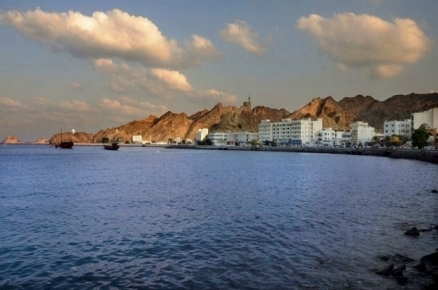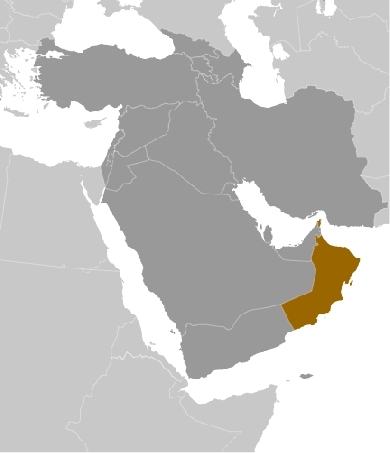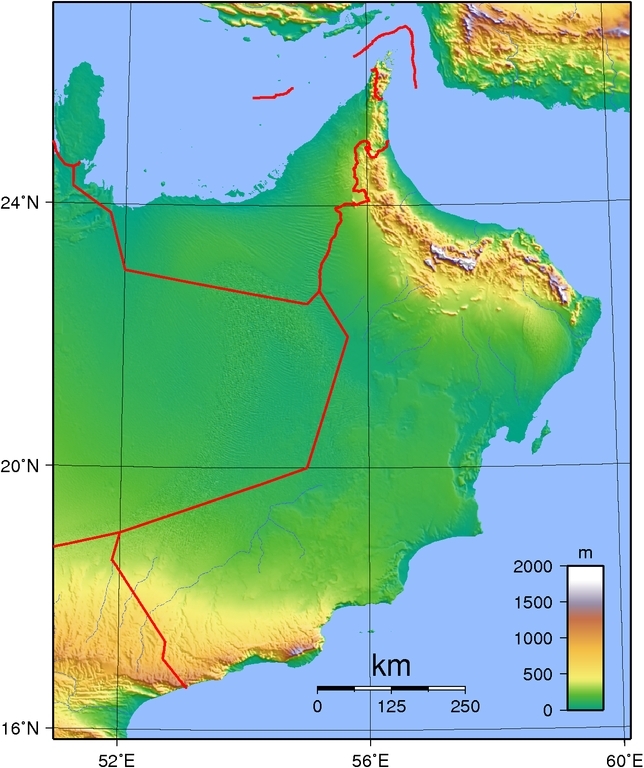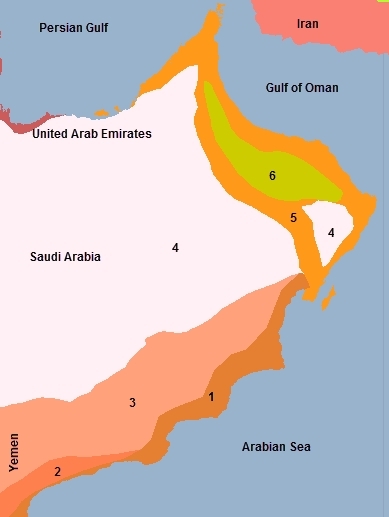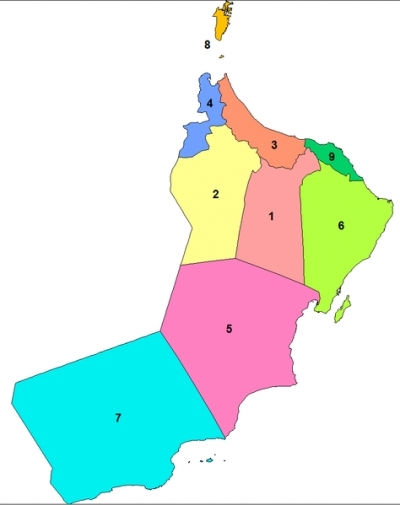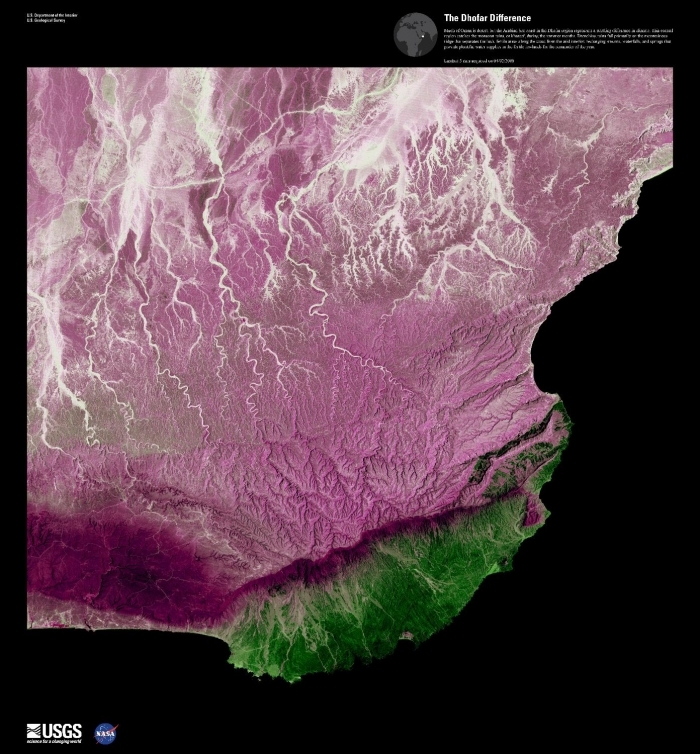Oman (About the EoE)
Contents
Oman
Countries and Regions of the World Collection  Oman is a nation of three million people in the Middle East, bordering the Arabian Sea, Gulf of Oman, and Persian Gulf, between Yemen and the United Arab Emirates (UAE).
Oman is a nation of three million people in the Middle East, bordering the Arabian Sea, Gulf of Oman, and Persian Gulf, between Yemen and the United Arab Emirates (UAE).
Oman is composed of three areas; a large contigous area of territory; the much smaller Musandam Peninsula (adjacent to Strait of Hormuz, a vital transit point for world crude oil); and Al Madhah, an even samller coast enclave half way between Musandam Peninsula and the rest of Oman.
Its major environmental issues include:
- rising soil salinity;
- beach pollution from oil spills; and,
- limited natural freshwater resources
Summer winds often raise large sandstorms and dust storms in interior.
Oman is susceptible to periodic droughts.
The inhabitants of the area of Oman have long prospered on Indian Ocean trade.
In the late 18th century, a newly established sultanate in Muscat signed the first in a series of friendship treaties with Britain.
Over time, Oman's dependence on British political and military advisors increased, but it never became a British colony.
In 1970, Qaboos bin Said Al-Said overthrew the restrictive rule of his father; he has ruled as sultan ever since. His extensive modernization program has opened the country to the outside world while preserving the longstanding close ties with the UK.
Oman's moderate, independent foreign policy has sought to maintain good relations with all Middle Eastern countries.
Inspired by the popular uprisings that swept the Middle East and North Africa in 2010-11, Omanis began staging marches and demonstrations to demand economic benefits, an end to corruption, and greater political rights. In February and March 2011, in response to protester demands, Qaboos pledged to create more government jobs and promised to implement economic and political reforms, such as granting legislative and regulatory powers to the Council of Oman and the introduction of unemployment benefits. Also in March, the Gulf Cooperation Council pledged $20 billion in financial aid to Oman and Bahrain over a 10-year period to assist the two nations in their struggle with Arab protests. Amid concessions made to oppositionists, the government during the summer continued to crack down on protests and demonstrations, and increasingly clamped down on the media. In October 2011, Qaboos issued a royal decree expanding the legislative powers of the Council of Oman to amend and approve draft legislation.
Geography
Location: Middle East, bordering the Arabian Sea, Gulf of Oman, and Persian Gulf, between Yemen and UAE
Geographic Coordinates: 21 00 N, 57 00 E
Area: 309,500 sq km
Land Boundaries: 1,374 km (Saudi Arabia 676 km, UAE 410 km, Yemen 288 km).
A boundary agreement was reportedly signed and ratified with UAE in 2003 for entire border, including Oman's Musandam Peninsula and Al Madhah exclave, but details of the alignment have not been made public
Coastline: 2,092 km
Maritime Claims:
territorial sea: 12 nm
contiguous zone: 24 nm
exclusive economic zone: 200 nm
Natural Hazards: summer winds often raise large sandstorms and dust storms in interior; periodic droughts
Terrain: central desert plain, rugged mountains in north and south. The highest point is Jabal Shams (2,980 m)
Climate: dry desert; hot, humid along coast; hot, dry interior; strong southwest summer monsoon (May to September) in far south
Topology of Oman. Source: Wikimedia Commons.
Ecology and Biodiversity
|
1. Arabian Peninsula coastal fog desert 2. Southwestern Arabian foothills savanna 3. Red Sea Nubo-Sindian tropical desert and semi-desert 4. Arabian Desert and East Sahero-Arabian xeric shrublands 5. Gulf of Oman desert and semi-desert 6. Al Hajar Al Gharbi montane woodlands Map source: World Wildlife Fund See also: People and SocietyPopulation: 3,090,150 (July 2012 est.) Note: this includes 577,293 non-nationals About 55% of the population lives in Muscat and the Batinah coastal plain northwest of the capital; about 215,000 live in the Dhofar (southern) region, and about 30,000 live in the remote Musandam Peninsula on the Strait of Hormuz. Some 815,000 non-nationals live in Oman, most of whom are guest workers from South Asia, Egypt, Jordan, and the Philippines. |
Since 1970, the government has given high priority to education in order to develop a domestic work force, which the government considers a vital factor in the country's economic and social progress. In 1986, Oman's first university, Sultan Qaboos University, opened. It has continued to expand, recently adding a law college, and remains the country's only major public university. In total, there are about 25 public post-secondary education institutions in Oman, including technical colleges, teacher training colleges, and health institutes.
There are three private universities and 20 private post-secondary education institutions in Oman, including a banking college, a fire and safety college, a dentistry college, and business and management colleges. Most of these public and private post-secondary education institutions offer 4-year degrees, while the remainder provide 2-year post-secondary diplomas. Since 1999, the government has embarked on reforms in higher education designed to meet the needs of a growing population. Approximately 40% of Omani high school graduates pursue some type of post-secondary education.
In July 2011 the Government of Oman announced 500 new scholarships annually for study in the United States, as part of an overall program of 1,500 scholarships for the year for Omani students going overseas. These scholarships are guaranteed for the length of undergraduate study, including up to a year and a half of intensive English language study prior to entering a degree program. The government also recently announced a new graduate scholarship program to award 1,000 scholarships over the following 5 years for study in the U.S., Canada, U.K., Australia, Germany, Japan, and Singapore.
Ethnic Groups: Arab, Baluchi, South Asian (Indian, Pakistani, Sri Lankan, Bangladeshi), African
Age Structure:
0-14 years: 31.2% (male 484,292/female 460,066)
15-64 years: 65.7% (male 1,133,329/female 856,701)
65 years and over: 3.1% (male 47,786/female 45,785) (2011 est.)
Population Growth Rate: 2.043% (2012 est.)
Birthrate: 24.33 births/1,000 population (2012 est.)
Death Rate: 3.42 deaths/1,000 population (July 2012 est.)
Net Migration Rate: -0.47 migrant(s)/1,000 population (2012 est.)
Life Expectancy at Birth: 74.47 years
male: 72.61 years
female: 76.43 years (2012 est.)
Total Fertility Rate: 2.87 children born/woman (2012 est.)
Languages: Arabic (official), English, Baluchi, Urdu, Indian dialects
Literacy (age 15 and over can read and write): 81.4% (2003 census)
Urbanization: 73% of total population (2010) growing at an annual rate of change of 2.3% (2010-15 est.)
History
Oman adopted Islam in the seventh century A.D., during the lifetime of the Prophet Muhammad. Ibadhism, a form of Islam distinct from Shiaism and the "Orthodox" schools of Sunnism, became the dominant religious sect in Oman by the eighth century A.D. Oman is the only country in the Islamic world with a majority Ibadhi population. Ibadhism is known for its "moderate conservatism." One distinguishing feature of Ibadhism is the choice of ruler by communal consensus and consent.
Contact with Europe was established in 1508, when the Portuguese conquered parts of Oman's coastal region. Portugal's influence predominated for more than a century. Fortifications built during the Portuguese occupation can still be seen at Muscat.
Except for a period when Persia conquered parts of Oman, Oman has been an independent nation. After the Portuguese were expelled in 1650 and while resisting Persian attempts to establish hegemony, the Sultan of Oman extended his conquests to Zanzibar, other parts of the eastern coast of Africa, and portions of the southern Arabian Peninsula. During this period, political leadership shifted from the Ibadhi imams, who were elected religious leaders, to hereditary sultans who established their capital in Muscat. The Muscat rulers established trading posts on the Persian coast and also exercised a measure of control over the Makran coast (now Pakistan). By the early 19th century, Oman was the most powerful state in Arabia and had a major presence on the East African coast.
Oman was the object of Franco-British rivalry throughout the 18th century. During the 19th century, Oman and the United Kingdom concluded several treaties of friendship and commerce. In 1908, the British entered into an agreement of friendship. Their traditional association was confirmed in 1951 through a new treaty of friendship, commerce, and navigation by which the United Kingdom recognized the Sultanate of Oman as a fully independent state.
When Sultan Sa'id bin Sultan Al-Busaid died in 1856, his sons quarreled over his succession. As a result of this struggle, the Omani empire--through the mediation of the British Government under the "Canning Award"--was divided in 1861 into two separate principalities--Zanzibar, with its East African dependencies, and Muscat and Oman. Zanzibar paid an annual subsidy to Muscat and Oman until its independence in early 1964.
During the late 19th and early to mid-20th centuries, the sultan in Muscat faced a rebellion by members of the Ibadhi sect residing in the interior of Oman, centered around the town of Nizwa, who wanted to be ruled exclusively by their religious leader, the Imam of Oman. This conflict was resolved temporarily by the Treaty of Seeb in 1920, which granted the imam autonomous rule in the interior, while recognizing the sovereignty of the sultan elsewhere.
Following the discovery of oil in the interior, the conflict flared up again in 1954, when the new imam led a sporadic 5-year rebellion against the sultan's efforts to extend government control into the interior. The insurgents were defeated in 1959 with British help. The sultan then terminated the Treaty of Seeb and eliminated the office of the imam. In the early 1960s, the imam, exiled to Saudi Arabia, obtained support from his hosts and other Arab governments, but this support ended in the 1980s.
In 1964, a separatist revolt began in Dhofar Province. Aided by communist and leftist governments such as the former South Yemen (People's Democratic Republic of Yemen), the rebels formed the Dhofar Liberation Front, which later merged with the Marxist-dominated Popular Front for the Liberation of Oman and the Arab Gulf (PFLOAG). The PFLOAG's declared intention was to overthrow all traditional Arab Gulf regimes. In mid-1974, PFLOAG shortened its name to the Popular Front for the Liberation of Oman (PFLO) and embarked on a political rather than a military approach to gain power in the other Gulf states, while continuing the guerrilla war in Dhofar.
With the help of British advisors, Sultan Qaboos bin Sa'id assumed power on July 23, 1970, in a palace coup directed against his father, Sa'id bin Taymur, who later died in exile in London. The new sultan was confronted with insurgency in a country plagued by endemic disease, illiteracy, and poverty. One of the new sultan's first measures was to abolish many of his father's harsh restrictions, which had caused thousands of Omanis to leave the country, and to offer amnesty to opponents of the previous regime, many of whom returned to Oman. He also established a modern government structure and launched a major development program to upgrade educational and health facilities, build a modern infrastructure, and develop the country's natural resources.
In an effort to end the Dhofar insurgency, Sultan Qaboos expanded and re-equipped the armed forces and granted amnesty to all surrendered rebels while vigorously prosecuting the war in Dhofar. He obtained direct military support from the U.K., Iran, and Jordan. By early 1975, the guerrillas were confined to a 50-square kilometer (20-sq. mi.) area near the Yemen border and shortly thereafter were defeated. As the war drew to a close, civil action programs were given priority throughout Dhofar and helped win the allegiance of the people. The PFLO threat diminished further with the establishment of diplomatic relations in October 1983 between South Yemen and Oman, and South Yemen subsequently lessened propaganda and subversive activities against Oman. In late 1987, Oman opened an embassy in Aden, South Yemen, and appointed its first resident ambassador to the country.
The northern tip of Oman, called the Musandam Peninsula, is strategically located on the Strait of Hormuz, the entrance to the Gulf, 35 miles directly opposite Iran. Oman is concerned with regional stability and security, given tensions in the region, the proximity of Iran and Iraq, and the potential threat of political Islam. Oman maintained its diplomatic relations with Iraq throughout the 1990-91 Gulf war while supporting the UN allies by sending a contingent of troops to join coalition forces and by opening up to prepositioning of weapons and supplies. In addition, since 1980 Oman and the U.S. have been parties to a military cooperation agreement, which was revised and renewed in 2010. Oman also has long been an active participant in efforts to achieve Middle East peace.
Following the terrorist attacks on the United States in September 2001, the Omani Government at all levels pledged and provided impressive support to the U.S.-led coalition against terrorism. Oman is a signatory of most UN-sponsored anti-terrorism treaties.
Government
Government Type: monarchy
Sultan Qaboos bin Sa'id rules with the aid of his ministers. His dynasty, the Al Sa'id, was founded about 250 years ago by Imam Ahmed bin Sa'id Al Bu Said. Sultan Qaboos is a direct descendant of the 19th-century ruler, Sa'id bin Sultan, who first opened relations with the United States in 1833. Since his accession in 1970, Sultan Qaboos has balanced tribal, regional, and ethnic interests in composing the national administration. The Council of Ministers, which functions as a cabinet, consists of 31 ministers (but only 29 ministries), all directly appointed by Qaboos. The Sultanate does not have political parties, and new powers that were granted to the bicameral representative bodies in 2011, which allow proposing and amending legislation, do not provide for a fully independent legislature.
In November 1991, Sultan Qaboos established the Majlis al-Shura (Consultative Council), which replaced the 10-year-old State Consultative Council, in an effort to systematize and broaden public participation in government. Representatives were chosen in the following manner: Local caucuses in each of the 59 districts sent forward the names of three nominees, whose credentials were reviewed by a cabinet committee. These names were then forwarded to the Sultan, who made the final selection. Since then, reforms have permitted Omanis to freely run for office in contested elections featuring universal adult suffrage.
The elected Consultative Council serves as a conduit of information between the people and the government ministries. The Oman Council, of which the Consultative Council comprises one half, can approve or suggest amendments to legislation, propose legislation, convoke service ministers, recommend policy, and conduct studies on public policy. It has no authority in the areas of foreign affairs, defense, security, and finance. In early 2003, Sultan Qaboos declared universal suffrage for the October 2003 Majlis al-Shura elections. Two women were elected to sit with 82 male colleagues in those elections, which were observed to be free and fair. Roughly 194,000 Omani men and women, or 74% of registered voters, participated in the elections. Elections were held again in 2007 and 2011.
The appointed Majlis al-Dawla (State Council) acts as the upper chamber in Oman's bicameral representative body. As of 2011, Sultan Qaboos had expanded the Majlis al-Dawla to 83 members from 53.
In November 1996, Sultan Qaboos presented his people with the "Basic Statute of the State," Oman's first written "constitution." It guarantees various rights within the framework of Shari'a and customary law. It partially resuscitated long dormant conflict-of-interest measures by banning cabinet ministers from being officers of public shareholding firms. Perhaps most importantly, the Basic Statute provides rules for the royal succession.
Oman's judicial system is based on Shari'a--the Quranic laws and the oral teachings of the Islamic Prophet Muhammad. Traditionally, family courts fell under the jurisdiction of the Ministry of Justice, Awqaf, and Islamic Affairs (since divided into the Ministry of Justice and the Ministry of Endowments and Religious Affairs). Oman's first criminal code was not enacted until 1974.
Capital: Muscat - 634,000 (2009)
|
Administrative divisions: 5 regions (manatiq, singular - mintaqat) and 4 governorates* (muhafazat, singular - muhafazat)
Independence Date: 1650 (expulsion of the Portuguese) Legal System: accepts compulsory International Court of Justice (ICJ) jurisdiction; and accepts International criminal court (ICCt) jurisdiction. In 1999, royal decrees placed the entire court system under the financial supervision of the Ministry of Justice, though the 1996 Basic Statute ensures the independence of the judiciary. Also, an independent Office of the Public Prosecutor (formerly a part of the Royal Oman Police) and a supreme court were created. Regional court complexes were envisioned to house the various courts, including the courts of first instance for criminal cases and Shari'a cases (family law and inheritance). |
International Environmental Agreements
Oman is party to international agreements on: Biodiversity, Climate Change, Climate Change-Kyoto Protocol, Desertification, Hazardous Wastes, Law of the Sea, Marine Dumping, Ozone Layer Protection, Ship Pollution, and Whaling.
Water
Total Renewable Water Resources: 1 cu km (1997)
Freshwater Withdrawal: 1.36 cu km/yr (7% domestic, 2% industrial, 90% agricultural)
Per Capita Freshwater Withdrawal: 529 cu m/yr (2000)
Access to improved sources of drinking water: 88% of population
Access to improved sanitation facilities: 87% of population (2008)
Much of Oman is desert, but the Arabian Sea coast in the Dhofar region represents a startling difference in climate shown in this false-color satellite image. This coastal region catches the monsoon rains, or khareef, during the summer months. Drenching rains fall primarily on the mountainous ridge that separates the lush, fertile areas (in green) along the coast from the arid interior (in pink), recharging streams, waterfalls, and springs that provide plentiful water supplies in the fertile lowlands for the remainder of the year. Image courtesy of USGS.
Agriculture
Agricultural products: dates, limes, bananas, alfalfa, vegetables; camels, cattle; fish
Irrigated Land: 590 sq km (2008)
Resources
Natural Resources: petroleum, copper, asbestos, some marble, limestone, chromium, gypsum, natural gas
Land Use:
arable land: 0.12%
permanent crops: 0.14%
other: 99.74% (2005)
Economy
Oman is a middle-income economy that is heavily dependent on dwindling oil resources. (See: Energy profile of Oman)
When Oman declined as an entrepot for arms and slaves in the mid-19th century, much of its former prosperity was lost, and the economy turned almost exclusively to agriculture, camel and goat herding, fishing, and traditional handicrafts. Today, oil and gas fuel the economy, and revenues from petroleum products have enabled Oman's dramatic development over the past 40 years.
Oil was first discovered in the interior near Fahud in the western desert in 1964. Petroleum Development (Oman) Ltd. (PDO) began production in August 1967. The Omani Government owns 60% of PDO, and foreign interests own 40% (Royal Dutch Shell owns 34%; the remaining 6% is owned by Compagnie Francaise des Petroles [Total] and Partex). In 1976, Oman's oil production rose to 366,000 barrels per day (b/d) but declined gradually to about 285,000 b/d in late 1980 due to the depletion of recoverable reserves. From 1981 to 1986, Oman compensated for declining oil prices by increasing production levels to 600,000 b/d. With the collapse of oil prices in 1986, however, revenues dropped dramatically. Production was cut back temporarily in coordination with the Organization of Petroleum Exporting Countries (OPEC)--of which Oman is not a member--and production levels again reached 600,000 b/d by mid-1987, which helped increase revenues. By 2000, production had climbed to more than 900,000 b/d; however, it declined to roughly 750,000 b/d for 2006. Now at 865,000 b/d, Oman is on track to reach its goal of 1 million b/d through the use of innovative enhanced oil recovery techniques.
Natural gas reserves, which will increasingly provide the fuel for industrial projects in Sohar and power generation and desalination plants throughout the Sultanate, stand at 24 trillion cubic feet. A liquefied natural gas (LNG) processing plant located in Sur was opened in 2000, with production capacity of 6.6 million tons per year (tons/yr), as well as unsubstantial gas liquids, including condensates. The completion of the plant's expansion in December 2005 increased capacity to 10.3 million tons/yr.
Oman does not have the immense oil resources of some of its neighbors. Total proven reserves are about 4.8 billion barrels. Oman's complex geology makes exploration and production an expensive challenge. Recent improvements in technology, however, have enhanced recovery.
Agriculture and fishing are the traditional way of life in Oman. Dates, grown extensively in the Batinah coastal plain and the highlands, make up most of the country's agricultural exports. Coconut palms, wheat, and bananas also are grown, and cattle are raised in Dhofar. Other areas grow cereals and forage crops. Poultry production is steadily rising. Fish and shellfish exports totaled $104.7 million in 2006.
The government is undertaking many development projects to modernize the economy, improve the standard of living, and become a more active player in the global marketplace. Oman became a member of the World Trade Organization in October 2000, and continues to amend its financial and commercial practices to conform to international standards. The country signed a free trade agreement with the United States in January 2006, which entered into force in January 2009. Oman continues to pursue, through the Gulf Cooperation Council (GCC), free trade agreements with a number of other key trading partners, including the European Union and India.
Increases in agriculture and especially fish production are believed possible with the application of modern technology. The Muscat capital area has both an international airport at Seeb and a deepwater port at Port Sultan Qaboos. The large-scale modern container port and free zone at Salalah, capital of the Dhofar Governorate, continues to operate at near-capacity levels. The government in early 2004 approved a project worth over $250 million to add two berths and extend the breakwater at the port. Port expansion with a focus on tourist cruise ships is underway at Port Sultan Qaboos, and a large industrial and container port and free zone is in operation in Sohar. A national road network includes a $400 million highway linking the northern and southern regions. The government also recently expanded passenger and cargo capacity at its main international airports at Seeb (Muscat) and Salalah, and will construct new airports at Sohar, Ras al-Hadd, and Duqm, where a dry dock recently began operations and a modern city and free zone are planned. In an effort to diversify the economy, in the early 1980s, the government built a $200-million copper mining and refining plant at Sohar. Other large industrial projects underway or being considered include an 80,000 b/d oil refinery, a large petrochemical complex, fertilizer and methanol plants, an aluminum smelter, and two cement factories. Industrial zones at Rusayl, Sohar, and several other locations showcase the country's modest light industries. Marble, limestone, copper, and gypsum may prove commercially viable in the future.
The Omani Government embarked on its seventh 5-year plan in 2006. In its efforts to reduce its dependence on oil and expatriate labor, the government projects significant increases in spending on industrial and tourism-related projects to foster income diversification, job creation for Omanis in the private sector, and development of Oman's interior. Government programs offer soft loans and emphasize the building of new industrial estates in population centers outside the capital area. The government is giving greater emphasis to "Omanization" of the labor force, particularly in banking, hotels, and oil and gas operations benefiting from government subsidies. Currently, efforts are underway to liberalize investment opportunities in order to attract foreign capital, such as updating the foreign investment law. From 1996-2008, Oman’s non-oil exports grew at a compound annual rate of more than 20%.
Some of the largest budgetary outlays are in the areas of health services and basic education. The number of schools, hospitals, and clinics has risen exponentially since the accession of Sultan Qaboos in 1970. After the Arab Spring protests in early 2011, the Government of Oman authorized a 1 billion Omani rial ($2.6 billion) increase in social spending--including stipends for military and civil service employees and scholarships--along with new mandates for the private sector such as an increase in the minimum wage and a push to boost hiring of Omani citizens.
U.S. firms face a small and highly competitive market dominated by trade with Japan and Britain and re-exports from the United Arab Emirates. The sale of U.S. products also is hampered by higher transportation costs and the lack of familiarity with Oman on the part of U.S. exporters. However, the traditional U.S. market in Oman, oil field supplies and services, should grow as the country's major oil producer continues a major expansion of fields and wells. Major new U.S. investments in oil production, industry, and tourism projects in 2005 totaled several billion dollars. Negotiations on the U.S.-Oman Free Trade Agreement (FTA) were successfully concluded in October 2005; the FTA was ratified by the U.S. Congress and signed by President George W. Bush in 2006. It entered into force on January 1, 2009, providing further impetus to bilateral trade and investment by offering advantages such as exemption from duties, national treatment, and 100% foreign ownership.
Because of declining reserves, Muscat has actively pursued a development plan that focuses on diversification, industrialization, and privatization, with the objective of reducing the oil sector's contribution to GDP to 9% by 2020. Tourism and gas-based industries are key components of the government's diversification strategy.
By using enhanced oil recovery techniques, Oman succeeded in increasing oil production, giving the country more time to diversify, and the increase in global oil prices throughout 2010 provides the government greater financial resources to invest in non-oil sectors.
GDP: (Purchasing Power Parity): $80.89 billion (2011 est.)
GDP: (Official Exchange Rate): $66.8 billion (2011 est.)
GDP- per capita (PPP): $26,200 (2011 est.)
GDP- composition by sector:
agriculture: 1.5%
industry: 51.3%
services: 47.2% (2011 est.)
Industries: crude oil production and refining, natural and liquefied natural gas (LNG) production; construction, cement, copper, steel, chemicals, optic fiber
Currency: Omani rials (OMR)
